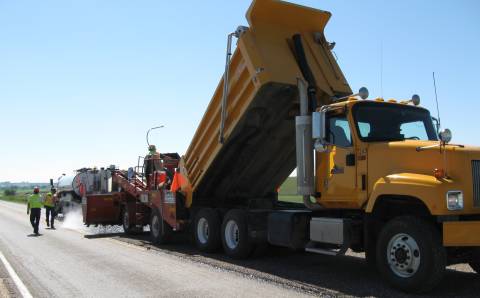No Parking
No parking signs will be placed approximately 72 hours before the work begins. The time frame for no parking is 7:00 am-5:30 pm Monday-Friday. Overnight and weekend parking is allowed. If vehicles are still located in the no parking area during the restricted time, they will be towed at the owner's expense. No parking signs will be taken down once all steps of the chip seal/fog seal processes are complete.
Reduced Speed Limit
Speed limit is reduced to 25 mph in the work zone area until the final sweep of the chip seal material is complete. The reason for the reduced speed limit is for work zone safety and to prevent broken windshields.
Road Work Ahead
The day of the chip seal operation, these signs will be placed to alert drivers of the work zone ahead. These signs will be removed daily when workers are no longer present.
Flagger Ahead
The day of the chip seal operation, these signs will be placed to alert drivers to be ready to take direction from flaggers through the work zone. These signs will be removed daily when workers are no longer present.
Digital Advanced Warning
Digital signs will be placed one week before the chip seal operation starts. The sign display information containing the impacted dates and that an alternate route is advised.
No Center Line
These signs give notification of the absence of center line stripe and are added right before the chip seal process begins and removed after the completion of striping.
The chip seal process involves several steps over several days that will proceed in the following order.
- Roadway sweeping – The surface of the road is swept to remove loose debris and dust to prepare it for proper adhesion of the asphalt emulsion.
- Application of asphalt emulsion – Large distributer trucks will spray a layer of emulsified asphalt on the surface of the road.
- Application of Aggregate - Immediately following the application of emulsion, a layer of aggregate (chip) is evenly applied on top of the emulsion. We utilize a chip spreader to transfer the aggregate from dump trucks to the road surface in a controlled manner.
- Compaction – The chip is then compacted with rubber tire rollers. This process re-arranges the aggregate and embeds it in the underlying layer of emulsion.
- Curing – The emulsion is allowed to cure which involves the water evaporating from the emulsion and the remaining oil stiffening. Traffic is allowed to use the roadway during this curing phase which, depending on weather, takes 24 to 48 hours.
- Sweeping – After the curing process is complete, the roadway is swept a second time to remove loose aggregate (chip) that did not become embedded in the emulsion.
- Fog Seal – A final layer of emulsion is applied over the top of the aggregate (chip) to increase the durability of the chip seal and to provide a deep black color. The black surface provides better contrast for the striping and improves the ability of the surface to absorb solar energy during the winter months enhancing safety by allowing the surface to melt off quicker after snow events
- Pavement Marking – The final step in the chip seal process is to replace the pavement markings that were covered up. This includes centerline and edgeline paint as well as thermoplastic symbols (arrows, onlys, RR Xing symbols, crosswalks)
All subdivisions that receive a chip seal will be swept one year following the completion of the chip seal to remove residual loose aggregate.

